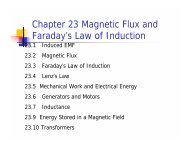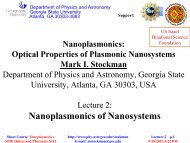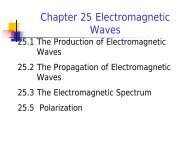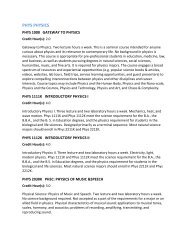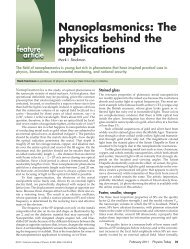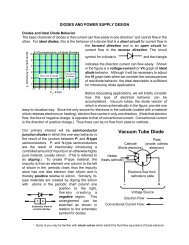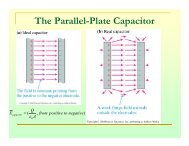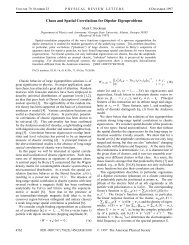C:\My Documents\feedback.wpd - Georgia State University
C:\My Documents\feedback.wpd - Georgia State University
C:\My Documents\feedback.wpd - Georgia State University
Create successful ePaper yourself
Turn your PDF publications into a flip-book with our unique Google optimized e-Paper software.
FEEDBACK<br />
INTRODUCTION<br />
The basic idea of feedback is straightforward: the results of some process are monitored,<br />
compared to a goal, and the input is adjusted based on the difference between the results<br />
and goal. This can be represented diagrammatically as follows:<br />
Input<br />
(goal)<br />
Comparison<br />
Point<br />
Process<br />
Results<br />
Monitor<br />
Generalized diagram of Feedback<br />
In fact, in everyday life, we can identify many examples of feedback: keeping our car on<br />
the road when driving, behavior modification techniques, etc. Of course, we will restrict our<br />
attention to electronic implementation of feedback. From that perspective, the signals to<br />
monitor and control may be voltage, current, or power. As we have done previously, we<br />
will further restrict ourselves to cases of voltage feedback.<br />
Amplifier-based voltage-feedback systems are basically as indicated below. (The set of +’s<br />
and -‘s indicate the standard sign convention for summing voltages in the input loop.) From<br />
the diagram, we can derive the relation between the input and output, also as indicated<br />
below.<br />
Feedback Amplifier Analysis :<br />
Voltage Feedback Amplifier System<br />
V = V + β V (KVL input loop analysis)<br />
V = AV = A(V + β V ) (Based on no - load output)<br />
V<br />
V<br />
it in o<br />
o it in o<br />
o<br />
in<br />
A<br />
= = G (Voltage - feedback<br />
1 - βA<br />
amplifier relation)<br />
+ +<br />
V it<br />
R oa<br />
V in<br />
R<br />
V o<br />
ia<br />
- -<br />
A*V it<br />
+ -<br />
ßV o<br />
ß<br />
V o<br />
DISCUSSION OF THE FEEDBACK RELATION<br />
Prior to making use of feedback, we need to examine the feedback relation for G in some<br />
detail. First, the factor represented by $ can be many things: another amplifier, a filter, a<br />
phase-shift network, a voltage divider, etc. However, we will represent its effect as the
Feedback Amplifiers GEORGIA STATE UNIVERSITY Page 2 of 8<br />
mathematical factor $ which in general is a complex number. Likewise, the amplifier<br />
may introduce phase-shift, and / or frequency dependence; thus A in general also is a<br />
complex number. The product A$, appearing in the denominator of the feedback<br />
relation is therefore in general a complex number.<br />
From our previous discussion of complex number algebra, we know that the magnitude of<br />
a product is the product of the magnitudes, and that the phase angle of a product is the<br />
sum of the phase angles. Thus, for emphasis, we can express A$ as<br />
Aβ =Aβ and φ = φ + φ Recall also that inversion (multiplication by -1) is the same<br />
Aβ A β.<br />
as a 180° phase shift, and that 0°, 360°, ...Nx360° all describe the in-phase condition.<br />
From this, we can identify two basic cases of the expression for G to examine further:<br />
1. A β > 0 ( Positive real number)<br />
means φA<br />
+ φβ<br />
= 0 , 360 ,..., n * 360<br />
Positive Feedback<br />
! ! !<br />
2. A β < 0 ( Negative real number)<br />
means φA<br />
+ φβ<br />
= 180 , 540 , ... 180 +n * 360<br />
Negative Feedback<br />
! ! ! !<br />
Of course, there are in-between cases where A$ is a complex number. However, these<br />
two cases listed above, where the A$ product is a real number, are very inportant for<br />
several reasons, some of which will be discussed below.<br />
Positive Feedback. Positive feedback is the situation where the adjustment is applied to<br />
reinforce (or add to) the difference between the goal and the results. Obviously. This<br />
adjustment moves the results even farther from the goal and is undesirable in most cases.<br />
(In psychology and behavior modification, the term “positive feedback” is often used;<br />
however, it matches our description only from the view that the feedback moves the results<br />
further away from an undesirable goal.) For example, in driving a car, one aim is to keep<br />
the car along the chosen path. This is accomplished by monitoring the actual path in<br />
comparison to that desired and applying an adjustment opposite to the difference. If the<br />
adjustment reinforced the difference, as would be the case with positive feedback, the path<br />
would become even more in error—perhaps leading to the ditch!<br />
Nevertheless, positive feedback in electronics has at least one clear application, that of<br />
producing oscillators. For example, consider the case A$ = 1, which makes the<br />
denominator 1 - A$ = 0, and G infinite! A physical interpretation of this condition is that $<br />
represents signal reduction in the feedback path while A represents restoration. That is,<br />
if A exactly restores that which was lost, then the feedback creates a self-sustaining signal<br />
(as long as it is started in the first place). If A > 1/$, the signal grows until limited by some<br />
other factor (power supply, etc.). In the case of A$ $1, no “input” in needed and the<br />
feedback amplifier circuit becomes as shown in the circuit below.
Feedback Amplifiers GEORGIA STATE UNIVERSITY Page 3 of 8<br />
Notice that V it = $V o and that the algebra<br />
seems contradictory if we write<br />
V = AβV when A β > 1.<br />
o<br />
o<br />
Voltage Feedback Amplifier System,<br />
Oscillator Configuration<br />
The condition for self-sustaining signals<br />
(or oscillation, called the Barkhausen<br />
Criterion, is<br />
A β = 1 ,<br />
+<br />
-<br />
+<br />
-<br />
V it<br />
R ia<br />
R oa<br />
A*V it<br />
V o<br />
or A β = 1 ,<br />
and φ + φ = 0, 360, ..., n* 360.<br />
A<br />
β<br />
! ! !<br />
ßV o<br />
ß<br />
V o<br />
For oscillators, a main application of<br />
positive feedback, $ is designed to have<br />
a frequency dependence so that A β → 1 @ f o.<br />
For example, consider the phase-shift<br />
oscillator sketched below. The amplifier is in the op-amp inverting configuration.<br />
Therefore, N A = 180° and at f o it is also<br />
necessary that N $ = 180°. An a.c. circuit<br />
Phase Shift Oscillator<br />
analysis of the RC network<br />
R<br />
(straightforward, but tedious) yields:<br />
f<br />
V2<br />
1<br />
β = =<br />
V1<br />
5<br />
⎡<br />
1<br />
⎤<br />
1<br />
1 - + j ⎢ - 6⎥<br />
2 2<br />
( ωRC) ⎢( ω ) ⎥ωRC<br />
⎣ RC ⎦<br />
R i<br />
C C C<br />
V 1 (= V out )<br />
R R R<br />
V 2 (=ßV o )<br />
V o / V i is purely real when the imaginary<br />
term in square brackets is zero, or when<br />
(TRC) 2 = 1/6. Also, when this condition is<br />
Vo<br />
1 1<br />
satisfied, β = = = - . Thus, for the phase-shift oscillator shown above,<br />
V 1 - 5⋅6 + j[0] 29<br />
i<br />
1<br />
the Barkhausen criterion is satisfied at ω0 = 2πf 0 = if A ≤- 29 ( A ≥29).<br />
6RC<br />
Negative Feedback. Negative feedback is the case more generally applied. For the<br />
example of driving described above, adjustment of the car’s direction opposite to the<br />
deviation corrects the deviation and is an example of negative feedback. Many<br />
applications of negative feedback are in control-system design (guidance systems, voltage<br />
regulators, etc.) However, because the phase shift of electronic (and mechanical devices)<br />
is a function of frequency, usually increasing with increasing frequency, it is necessary that<br />
the design prevent unintentional occurrence of the Barkhausen condition. (You wouldn’t<br />
like being a passenger on a plane where the autopilot exhibited this condition!) In fact, the<br />
central problem of control-system design is to provide quick response while preventing<br />
occurrence of the Barkhausen condition.
Feedback Amplifiers GEORGIA STATE UNIVERSITY Page 4 of 8<br />
Several circuits we have already considered employ negative feedback. Of these, we will<br />
examine two in more detail, the non-inverting amplifier configuration with operational<br />
amplifiers and our transistor amplifier. In addition, we will examine a voltage regulator<br />
system using negative feedback.<br />
Negative Feedback and the Non-inverting Op-Amp Circuit. Shown below is a re-sketch<br />
of this amplifying circuit emphasizing the connection between the output and the input.<br />
The main new element in the analysis is<br />
retaining A as a finite value. (R in is still<br />
taken as large enough to make I amp ~ 0.)<br />
Analysis of the circuit yields:<br />
V + = Vin<br />
⎛ R2<br />
⎞<br />
V - = Vout<br />
⎜ ⎟<br />
⎝R 1+ R2<br />
⎠<br />
⎛ VoutR2<br />
⎞<br />
out + - ⎜ in ⎟<br />
⎝ 1 2 ⎠<br />
Vout<br />
A<br />
= = G<br />
Vin<br />
1 + AR 2<br />
(R + R )<br />
1 2<br />
Non-Inverting Op-Amp<br />
V<br />
V out = A(V + - V - )<br />
in<br />
A<br />
V - = V out R 2 /(R 1 + R 2 )<br />
R 1<br />
R 2<br />
V = A(V - V ) = A V - R + R<br />
⎛ ⎞<br />
Since this expression is different from that obtained previously, but the previous derivation<br />
used the approximation A →∞,<br />
we should examine this new result for correspondence to<br />
the earlier one. Doing so gives the expressions:<br />
⎛<br />
⎞<br />
lim ⎛ V ⎞ ⎜ A ⎟ ⎜ 1 ⎟ R + R R<br />
→∞⎜ ⎟= lim<br />
→∞⎜ ⎟= lim<br />
→∞⎜<br />
⎟= = 1 +<br />
A<br />
⎝ V A A<br />
⎠ ⎜1 +<br />
AR2 ⎟ 1 R2<br />
⎜ R R<br />
⎟<br />
⎝ (R 1 + R 2) +<br />
⎠ ⎝ A (R 1 + R 2)<br />
⎠<br />
out 1 2 1<br />
in 2 2<br />
Things are OK since this is the same result as before. Also, by examination of the<br />
R2<br />
expression for G, it is evident that A β = -A for this circuit.<br />
R + R<br />
1 2<br />
Example 1: Calculate the actual voltage “Gain” of a circuit in the non-inverting op-amp<br />
configuration when A = 50 and R 1 / R 2 = 99.<br />
50 50 1<br />
Solution: Using the result above, we get G = = = 33 .<br />
R2<br />
50<br />
1 +<br />
3<br />
1 + 50<br />
R + 99R 100<br />
2 2<br />
Example 2: Calculate the minimum value of A to make the actual voltage “Gain” of a<br />
circuit in the non-inverting op-amp configuration at least 90% of the “ideal value”<br />
when R 1 / R 2 = 99.
Feedback Amplifiers GEORGIA STATE UNIVERSITY Page 5 of 8<br />
Solution: The “ideal” value is G = 1 + R 1 / R 2 = 1 + 99 = 100. So, the question becomes<br />
that of finding the value of A making G $90. By algebraic rearrangement, we can<br />
G<br />
solve (or re-derive) the expression above for A: A =<br />
.<br />
R<br />
Thus the value<br />
2<br />
1 - G R + R<br />
needed is A $ 90 / (1 - 0.9) = 900.<br />
1 2<br />
Feedback Voltage Regulator: Using feedback to accomplish the voltage regulation<br />
function can be envisioned as in the diagram. The concepts are a monitor of the actual<br />
output which compares it to the reference (desired behavior) and controls the “adjust”<br />
element. An actual implementation of such a circuit (for positive voltages) using an<br />
amplifier and an NPN transistor is shown beside the diagram.<br />
Conceptual Feedback Voltage Regulator<br />
Feedback Voltage Regulator<br />
(Positive Voltages)<br />
Unreg. Input<br />
Adjust<br />
Output<br />
+ Unreg. in<br />
V out<br />
R 1<br />
Reference<br />
Monitor<br />
R 2<br />
V ref<br />
V = V<br />
+ ref<br />
⎛ R2<br />
⎞<br />
V - = Vout<br />
⎜ ⎟<br />
⎝R 1+ R2<br />
⎠<br />
V oa = V b = A(V + - V - )<br />
V = V -0.7 = A(V - V )-0.7<br />
out b + -<br />
⎛ VoutR2<br />
⎞<br />
V out = A⎜V ref - ⎟-0.7<br />
⎝ R 1+ R2<br />
⎠<br />
⎛ ⎞ ⎛ ⎞<br />
⎜ ⎟ ⎜ ⎟<br />
⎜<br />
A<br />
⎟ ⎜<br />
0.7<br />
V ⎟<br />
out = Vref<br />
-<br />
⎜ R2 ⎟ ⎜ R2<br />
⎟<br />
⎜<br />
1 +A<br />
⎟ ⎜<br />
1 +A<br />
⎟<br />
⎝ R 1+ R2 ⎠ ⎝ R 1+ R2<br />
⎠<br />
Analysis of the circuit is as follows:<br />
The second term in the analysis, resulting<br />
from the base-emitter voltage of the<br />
transistor, is insignificant in most cases.<br />
Specifically, the denominator is the same in<br />
both terms; the numerator of the first is Avref ,<br />
while that of the second is 0.7. In cases<br />
where A is large, the first will clearly be<br />
dominant. Therefore, except for testing to<br />
see how important the second term might<br />
be, we will consider only the first term.<br />
One other aspect of the analysis is the<br />
similarity with the result obtained above for<br />
the non-inverting op-amp configuration.<br />
Actually, this is not accidental since the voltage regulator circuit can be rearranged as<br />
shown below to emphasize its close relationship to the non-inverting amplifier circuit.
Feedback Amplifiers GEORGIA STATE UNIVERSITY Page 6 of 8<br />
In fact, the voltage regulator is the noninverting<br />
amplifier with a transistor in the<br />
output. In addition, V ref is simply the “input.”<br />
This correspondence provides another<br />
insight we will use later.<br />
Returning now to the voltage regulator<br />
analysis above, we see that the main term<br />
in the expression is<br />
Voltage Regulator Related to<br />
Non-Inverting Op-Amp<br />
V ref<br />
+ Unreg. in<br />
V<br />
R out<br />
1<br />
R 2<br />
⎛<br />
⎞<br />
⎜<br />
⎟<br />
⎜<br />
A<br />
V ⎟<br />
out = Vref<br />
which is the<br />
⎜ R2<br />
⎟<br />
⎜<br />
1 + A<br />
⎟<br />
⎝ R 1 + R 2 ⎠<br />
same as that for the non-inverting amplifier.<br />
By the same algebra, for large A, the result<br />
for the output is simply V out = V ref (1 + R 2 / R 1 ). In other words, the output is simply the<br />
“amplified” version of the reference.<br />
Finally, it is important to point out that the role of the reference voltage is to provide the<br />
definition of “steady.” It is not necessary that the reference voltage be equal to that sought<br />
by the regulator since the output is multiplied by the factor determined by the resistors as<br />
described above. The purpose of the regulator is to provide an output with voltage steady<br />
as possible, but it can do so only with by comparison with a standard, or reference, defining<br />
“steady.” This is a role played often by zener diodes in electronic voltage regulators.<br />
Example 3: Calculate the error in ignoring the “second” term and the actual value of A in<br />
the voltage regulator analysis for the case A = 25, V ref = 1.25V, and R 1 / R 2 = 9.<br />
Solution: The “ideal” value is V o = V ref ( 1 + R 1 / R 2 ) = 12.5V. The actual value using the<br />
numbers given is V o = 1.25 x25 / (1 + 25/10) - 0.7 / (1 +25 / 10) = 8.9V. So the error<br />
is ~ 3.6 V, or about 29%. In fact, increasing A to 250 yields V out ~ 12v, reducing the<br />
error to a much smaller amount.<br />
Negative Feedback in Our Transistor Amplifier. As you might suspect by now, the very<br />
simple relation derived for amplification of our simple transistor amplifier circuit suggests<br />
the presence of some effect such as feedback. In fact negative feedback plays a direct<br />
and important role in the circuit. We can see this by revisiting the amplifying portion of the<br />
circuit as sketched below. The one thing we need to modify is the absolutely constant<br />
difference between base and emitter voltages. We knew this was not strictly true earlier,<br />
but must make use of the fact that the base-emitter junction can be better approximated<br />
as a resistance h ie ( nominal values are ~1k). Thus, while the base-emitter junction is<br />
conducting, V be ~ h ie I b , and V be is not exactly constant
Feedback Amplifiers GEORGIA STATE UNIVERSITY Page 7 of 8<br />
In the circuit, the voltages expressed in lower case<br />
are to be understood as the changing components<br />
only. Recall that the circuit is an a.c. amplifier only;<br />
thus only voltage changes are important.<br />
Transistor Amplifier for<br />
Feedback Identification<br />
Analysis of the circuit is as follows:<br />
v in = vb<br />
v o = v c = -i c Rc<br />
vR o e<br />
v e = i c R e = -<br />
Rc<br />
v b - v<br />
i c = hfei b = h fe<br />
h<br />
ie<br />
e<br />
v - v h ⎛ v R<br />
v o =- Rch fe = - Rc ⎜v in +<br />
hie hie ⎝ Rc<br />
⎛ hfe<br />
⎞<br />
⎜- Rc<br />
⎟<br />
vo<br />
⎝ hie<br />
⎠ (- Rchfe)<br />
A = = =<br />
vin ⎛ hfeRe<br />
⎞ ( h ie + hfeRe<br />
)<br />
⎜1 + ⎟<br />
⎝ h ie ⎠<br />
b e fe o e<br />
⎞<br />
⎟<br />
⎠<br />
v b<br />
= v in<br />
h ie<br />
R c<br />
v c = -i c R c<br />
v e = i c R e<br />
The positive sign of the second term in the denominator indicates the negative feedback.<br />
Our approach actually used the approximation h ie = 0, which yields our result, that the<br />
amplification A = -R c / R e . This expression also shows the appropriate version for A in the<br />
case R e becomes zero: A = -R c h fe /h ie , an result heavily dependent on electrical parameters<br />
of the transistor.<br />
Comments on Use of Negative Feedback in General with Amplifiers. The insight from<br />
comparing the voltage regulator to the non-inverting amplifier circuit will now be useful in<br />
understanding the value of negative feedback in general use with amplifier design.<br />
Specifically, feedback in general compares the result of a “process” to a “goal” and makes<br />
“adjustments” based on the difference. Negative feedback makes the adjustments in a<br />
way tending to reduce the difference or “error.”<br />
In general-purpose amplifiers, the input is the “reference” to which the output is to be<br />
compared. Thus, negative feedback has the property of reducing amplifier-induced<br />
distortion.<br />
Effect of feedback on Input and Output Resistances.<br />
Our final task will be to examine the correspondence between the characteristics of the<br />
basic amplifier, the feedback connection, and the effective input and output resistances of<br />
the circuit including feedback. The “standard” circuit from above is copied below for this<br />
purpose.<br />
Effective Input Resistance. As before, the approach will be based on the Thevenin<br />
concept. For the input resistance, we will “apply” an input voltage, and seek a relation<br />
between it and the resulting current so that R in = V in / I in . By examination of the circuit, we<br />
can see the following:<br />
R e<br />
+V s
Feedback Amplifiers GEORGIA STATE UNIVERSITY Page 8 of 8<br />
V V GV 1 V<br />
I in = = = =<br />
R AR AR (1- Aβ<br />
) R<br />
Vin<br />
R in = = (1- Aβ<br />
) Ria<br />
I<br />
it o in in<br />
ia ia ia ia<br />
in<br />
Thus, for positive feedback, where 1-A$<br />
is less than 1 and may approach zero, the<br />
input resistance is less than that of the<br />
basic amplifier. In contrast, for negative<br />
feedback, where 1-A$ is positive and<br />
greater than 1, the effective input resistance<br />
)<br />
)<br />
V = AV = GV<br />
out open it in<br />
AV<br />
it<br />
I out =<br />
short R oa<br />
AVin<br />
Vout )<br />
open GV in (1- A β ) Roa<br />
R out = = = =<br />
I out ) AVit<br />
AVin<br />
(1- A β )<br />
short<br />
R R<br />
oa<br />
Voltage Feedback Amplifier System<br />
+<br />
I in<br />
+<br />
V it<br />
R oa<br />
V in<br />
R<br />
V o<br />
ia<br />
- -<br />
A*V it<br />
+ -<br />
is greater than that of the basic amplifier. Thus, in terms of a general-purpose voltage<br />
amplifier, negative feedback enhances the input resistance.<br />
Effective Output Resistance. Also as before, our approach will be to use the Thevenin<br />
perspective. Specifically, we will seek the ratio of the open-circuit output voltage to the<br />
short-circuit output current.<br />
However, the case when the output is short-circuited must be examined more carefully<br />
since V o = 0 under those circumstances. Specifically, when V o = 0, $V o = 0, also and<br />
V it = V in . So,<br />
oa<br />
ßV o<br />
ß<br />
V o<br />
For positive feedback, where 1-A$ will be less than 1, and may approach zero, the<br />
effective output resistance is greater than that of the basic amplifier. On the other hand,<br />
for negative feedback, where 1-A$ will be greater than 1, the output resistance is less than<br />
that of the basic amplifier. In summary, for a general-purpose voltage amplifier,<br />
negative feedback improves the effective output resistance.<br />
Conclusions: Both positive and negative feedback have useful applications. In particular,<br />
negative feedback has a wide range of applications in control-system technology.<br />
Moreover, negative feedback provides improved characteristics of general-purpose<br />
amplifiers: distortion is reduced, the input resistance is increased, and the output<br />
resistance is decreased.



